#binaca geetmala hindi songs
Text
From Goa to Maldives: The Ultimate Bollywood Beach Playlist for Your Next Vacation

Grab your sunglases, pack your swimsuit, and get ready to dance in the sand because we have the ultimate Bollywood beach playlist for your next vacation! Whether you’re lounging on the shores of Goa or soaking up the sun in Maldives, these tunes are guaranteed to transport you straight into a Bollywood movie scene. So turn up the volume and let’s dive into our top picks for a perfect day at the beach with some seriously groovy beats.
Introduction to Bollywood and its Music
Bollywood, the vibrant and thriving Indian film industry, has captured the hearts of millions worldwide with its captivating storytelling, colorful visuals, and, of course, its soul-stirring music. The music of Bollywood plays an integral role in shaping the emotions and narratives of the films, creating a unique identity that sets it apart from other cinematic experiences.
Bollywood films are characterized by colorful costumes, vibrant music, and elaborate dance sequences. Bollywood movies are often musicals, and feature songs that are integrated into the story. These songs are known as “filmi” songs, and are often very popular in their own right.
Bollywood music is characterized by catchy melodies, energetic rhythms, and emotional lyrics. Filmi songs often make use of traditional Indian instruments such as the sitar, tabla, and sarangi, as well as Western
instruments.
If you’re looking for some Bollywood tunes to get you in the mood for your next beach vacation, check out our ultimate Bollywood beach playlist below!
Top 10 Bollywood Songs About Beaches
Bollywood has always been fascinated by the beach. Whether it’s shooting a romantic song against the backdrop of the setting sun or a group of friends frolicking in the waves, there’s something about the beach that just makes for good cinema. Here are our top 10 Bollywood songs about beaches:
“Oh Girl You are Mine” – Housefull
“Party On My Mind” – Race 2
“Tumhi Ho Bandhu” – Cocktail
“Sunny Sunny” – Yaariyan
“Shut Up And Bounce” – Dostana
“Salaam Namaste” – Salaam Namaste
“Slowly Slowly” – Go Goa Gone
“Ghungroo Toot Gaye” – War
“Besharam Rang” – Pathaan
“Aaj Dil Gustakh Hai” – Blue
These songs are known for their catchy tunes, beach visuals, and foot-tapping beats that make them popular choices for beach parties or a fun day at the shore.
How to Create a Beach Playlist for Your Next Vacation
When it comes to packing for a beach vacation, there are a few essential items you’ll need: sunscreen, swimsuits, and of course, a great playlist. Whether you’re headed to Goa or the Maldives, we’ve got the perfect Bollywood beach playlist to get you in the vacation mindset.The right music can create the perfect ambiance, set the mood, and make your time by the ocean even more memorable.
Consider the Vibe:
Start by envisioning the overall vibe you want to create with your playlist.Are you looking for a relaxing and laid-back atmosphere, or do you want to infuse your beach experience with high-energy and excitement? Consider
the type of beach you’re visiting, the activities you plan to engage in, and the overall mood you want to set. This will help you select songs that align with your desired beach experience.
Include Beach-themed Songs:
To capture the essence of the beach, incorporate songs that directly reference the ocean, sand, sun, or summer. Look for tracks that have lyrics or titles related to the beach. These songs will instantly transport you to the
seaside and add a touch of tropical charm to your playlist.
Explore Genres:
Beach playlists don’t have to be limited to a specific genre. Experiment with different styles of music to cater to different moods and preferences. Consider including genres such as reggae, tropical house, surf rock, indie
pop, or even Bollywood beach tracks. Mix and match various genres to create an eclectic playlist that keeps things interesting.
Balance Upbeat and Chill:
A well-rounded beach playlist strikes a balance between lively, upbeat tunes and more relaxed, soothing tracks. Include energetic songs to keep the energy high during beach games, water activities, or parties. Simultaneously, include softer melodies that allow you to unwind, soak up the sun, and enjoy the serene beauty of the beach.
Timeless Classics and Contemporary Hits:
Blend timeless classics with current chart-toppers to appeal to a wide range of musical tastes. Iconic beach-themed songs like “Kokomo” by The Beach Boys or “Under the Boardwalk” by The Drifters will evoke a sense of nostalgia, while recent hits can add a fresh and modern touch to your playlist.
Collaborative Playlist:
Involve your travel companions in the playlist creation process by setting up a collaborative playlist. Encourage everyone to contribute their favorite beach tracks, ensuring that everyone’s tastes and preferences are represented. This collaborative effort will make the playlist more diverse and personalized, creating a memorable soundtrack for your vacation.
Mood Transitions and Flow:
Consider the flow and mood transitions between songs to ensure a seamless listening experience. Group together songs with similar energy levels or complementary themes. Arrange the playlist in a way that builds up and eases down when needed, creating a dynamic yet cohesive journey through the music.
Conclusion
With this Bollywood beach playlist, you can look forward to an exciting vacation full of fun and unique experiences. From the beaches of Goa to the beautiful waters of Maldives, these songs are sure to get your toes
tapping and your heart racing as you explore all that these amazing destinations have to offer. So what are you waiting for? Pack up those bags – it’s time for a memorable vacation!
#From Goa to Maldives: The Ultimate Bollywood Beach Playlist for Your Next Vacation#yesudas song lyrics#binaca geetmala hindi songs#filmfareawards#binaca geetmala#binaca geetmala 1960 to 1970#old hindi songs lyrics#filmfare award winners 1960#old hindi songs#music
2 notes
·
View notes
Text
Lyrics Dil Deewana Bin Sajna Ke (Female)
Lyrics Dil Deewana Bin Sajna Ke (Female)
Dil Deewana Bin Sajna Ke (Female) – Song contents:
Lyrics in EnglishHindi LyricsYouTube VideoSong TriviaMore
Lyrics in English | Dil Deewana Bin Sajna Ke (Female) | Maine Pyar Kiya (1989) | Salman Khan, Bhagyashree | Lata Mangeshkar
Ho (2)La (9)Humm (4)Ho (4)
Dil DeewanaBin Sajna KeMaane NaDil DeewanaBin Sajna KeMaane Na
Ye Pagla HaiSamjhaane SeSamjhe NaYe Pagla HaiSamjhaane SeSamjhe…

View On WordPress
#1980s Evergreen Hindi Songs#A to Z Bollywood Songs#A to Z Hindi Songs#A to Z Song Lyrics#A to Z Songs#All Time Best Hindi Songs#Best Hindi Songs of 80s#Best of Raamlaxman and Lata Mangeshkar#Best Romantic Songs of 1989#Best Romantic Songs of 80s#Best Solo Songs of Lata Mangeshkar#Best Songs Composed by Raamlaxman#Best Songs of Bhagyashree#Best Songs Written by Asad Bhopali#Best Soulful Bollywood Songs#Best Soulful Songs of 1989#Best Soulful Songs of 80s#Bhagyashree Songs#Binaca Geetmala 1989#Bollywood Songs of 1989#Hindi Songs of 1989#Lata Mangeshkar Songs#Maine Pyar Kiya (1989) Songs Lyrics#Salman Khan Songs#Solo Songs of Lata Mangeshkar#Songs Available on Bollywood Classics#Songs Available on Saregama Music#Songs available on YouTube Channel of Rajshri#Songs composed by Raamlaxman#Songs from Maine Pyar Kiya (1989)
0 notes
Text
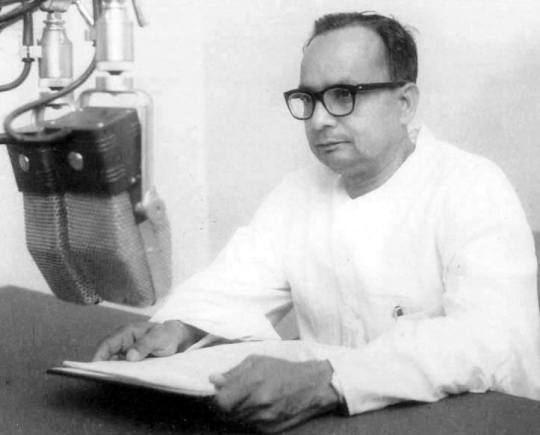
Today, we remember Pandit Narendra Sharma on his birth anniversary. He was a famous poet, wrote songs for Hindi movies, and started the radio channel Vividh Bharati (02/28).
Pandit Sharma was known for his beautiful poetry, songwriting, and deep knowledge of Hindi and Urdu languages. He brought a special style to Indian movies by mixing old Indian poetry styles with the beauty of Urdu poetry. He played a big role in making the radio channel Vividh Bharati very popular when it was struggling, bringing its listeners to nearly 35 crore people.
He wrote unforgettable songs for movies like “Jyoti Kalash Chhalke” from “Bhabhi Ki Chudiyan” in 1961, and both “Yashomati maiya se bole nandlala” and the main song “Satyam Shivam Sundaram” from the movie “Satyam Shivam Sundaram” in 1979.
Pandit Sharma was born on February 28, 1913, in Jahangirpur, Uttar Pradesh. He studied English literature at Allahabad University and was part of India’s fight for independence. He was friends with famous poet Harivanshrai Bachchan and wrote poetry in Hindi that many people loved.
In 1942, he was invited to Bombay (now Mumbai) to write songs for movies. His first movie as a songwriter was “Hamaari Baat” in 1943, starring Raj Kapoor. He also suggested the stage name ‘Dilip Kumar’ for the actor Yusuf Khan, a name that became very famous in Indian cinema. His songs, especially when sung by Lata Mangeshkar, became very popular.
Apart from movies, Pandit Sharma’s work in radio was groundbreaking. In 1952, India’s Prime Minister Jawaharlal Nehru asked him to help start Vividh Bharati on All India Radio, which became a huge success and had a massive audience by 1970. Some famous radio shows, like Binaca Geetmala, became very popular because of him. He worked with Vividh Bharati until he retired.
Pandit Sharma also wrote many religious songs and poems outside of movies. One of his most famous songs is the title track of the movie “Satyam Shivam Sundaram,” which talks about beauty and truth. This song got him a nomination for a Filmfare award.
He passed away on February 11, 1989, but his work continues to inspire many with its deep messages about life and beauty.
1 note
·
View note
Text
FURTHER EVIDENCE ON BRITISH DOMINION RAJ IN POST-1947 (SUPPOSEDLY INDEPENDENT) INDIA, VIA ‘MANAGEMENT & ULTIMATE CONTROL’ OVER INDIA’S & THE SUBCONTINENT’S POPULAR COMMUNICATION IE RADIO! ..........................................................................................................................................................THE ‘REAL REASON’ FOR THE RISE TO UNPARALLELED FAME, OF SRI LANKA’S ‘RADIO CEYLON’, OVER INDIA’S ‘ALL INDIA RADIO’!
A strange dichotomy in press or media workings from 50’s India, came to our attention at Indies, making us investigate it’s roots, & the revelations from it & deeper emerging links to the Indian panorama of then, is what’s presented in form of this blog.
Now all regular readers of Indie blogs, would’ve taken notice of the Indie revelation from month back, of the pre-1977 Indian Film Censors rule, of not allowing film shootings within the land, till every 3 reels of each film were made to pass thru & be certified by censors before proceeding ahead. In light of this, emerged another unrelated claim stating how twas the Indian Information & Broadcasting Min of 1950’s India, B.V. Keskar, I & B Minister from 1952-1962, that outright banned the broadcast of all Hindi songs in 1952, for supposedly being too crass & uncultured, thus paving way for the emergence & prosperity of India’s rival business, Sri Lanka’s state radio broadcast service ‘Radio Ceylon’ (most famous to audiences of today, for hosting Ameen Sayani’s ‘Binaca Geetmala’, a weekly Top 10/20 Hindi Film Songs rating & broadcast show) that became immensely popular on account of such ‘folly’ by Mr. Keskar.
And this theory was bought by the nation enmasse, for Mr. Keskar being a known proponent of the classical arts, & who In an article in The Hindu (19 July 1953), had argued that “The country’s appreciation for classical music has fallen and was on the point of extinction, particularly in North India, & the onus of making his countrymen intimate with (classical music) that therefore was bestowed on AIR.”
“We must make (ourselves) familiar with our traditional music," was what he’d declared.
Now further research on the matter gives us no other direct quotes or even second-hand convos from Keskar on the matter of Hindi Film Songs being degenerative or a bad influence on Indian society, ever, anywhere! .. All such talk, attributing such motives to him, only appearing in independent (?) columns of journalists, assuming his self-asserted appreciation for Indian classical music as a direct potential assault on Hindi film Music, in some zero sum game, that being the decided motive for the AIR Film Music ban, no further questions thence to be asked!
This theory may even have worked in unknowing & gullible 1950’s India, but to us 75 yrs later, armed with Google baba & other means of info, the knowledge of real facts, that smelt of something far more sinister or atleast shady to begin with-
HOW WAS IT EVER POSSIBLE, THAT THE SAME I & B MINISTRY THAT OVERSAW, CERTAINLY SINCE INDEPENDENCE & ALSO BEFORE, WHAT SONGS WERE FIT TO BE TELECAST OR SCREENCAST (IE WITH VISUALS, MOREOVER) IN HINDI MOVIES OF THEN, WITH A METICULOUS MICROSCOPE, WOULD FIND THE SAME SONGS OBJECTIONABLE IN THEIR MERE PODCAST OR TRANSMISSION (W/O VISUALS), OVER A PUBLIC CARRIER ‘ALL INDIA RADIO (AIR)’ ALSO RUN ENTIRELY BY THE I & B MINISTRY??!!
Further, we are told that AIR’s situation improved after Keskar was removed & AIR’s new ‘Vividh Bharati service” division was started, now allowing the playing of Hindi songs, thus gaining popularity, & finally beginning to bring in rewards to Indian public entrepreneurship.
Only to learn upon some more research that:
1. Mr. B.V. Keskar was the I & B minister continuously for 10 yrs from 1952 – 1962, while ‘Vividh Bharati’ began services in October 1957! Ie. Keskar also oversaw the emergence of Vividh Bharati in AIR during his leadership.
2. It is learnt that parent body AIR still didn’t allow of advertising slots on this new ‘Vividh Bharati’ channel, even then, thus refusing the chance of generating revenue & sprucing up it’s programming & presentation. This infact reportedly continuing into early 1970’s.
All this while rival state broadcaster, Sri Lanka’s ‘Radio Ceylon’, was reportedly earning millions upon millions of rupees, via the biggest & hottest commodity of the nation since independence, in Sri Lanka or India – Radio! Far far more monopolistic in attracting the maximum audience & ad revenue & trade then, as one would imagine, on account of there being no rival modes of entertainment or mass enjoyment then! RADIO WAS UPTO TEN TIMES MORE PROFITABLE AND ATTRACTIVE & PRESTIGIOUS A VENTURE & A DOMINATING (& CONTROLLING) PUBLIC INFLUENCE, THAN EVEN THE TELEVISION OF TODAY!
Which brings one to the obvious question, as to why would the Indian Govt, allow the clearly most potentially impactful & most public interfacing & public controlling Ministry, take a string of the stupidest upon stupidest of decisions, one after the other, for upto years to decades on end, that too, & need it be said, with a rival & unimaginably successful & profitable & national coffer-bourgeoning business model, in just the neighbouring nation, using the Indians’ own intellectual property to increase their own nation’s wealth, all to India’s detriment!????
Ofcourse also to how the same supposedly Hindi Film music-phobic I & B Minister Keskar, had such a change of heart, to first unilaterally declare such a vastly unpopular & need I say, electorally impactful decision in 1952, & then do a 180 degree turn in just 5 yrs, & undo the same decision unilaterally in 1957, unquestioned or un-investigated upon further, forever thereafter!
Btw. B. V. Keskar continues to be the longest serving I & B Min in Indian democratic history, having served on this post for a full 10 yrs, that’s 5 times more than the average term duration of 2 yrs for Ministers holding this post in India thereafter!
Does anyone even remotely believe that Nehru of all people, SO hands-on in all his affairs, that his own 1950’s Finance Minister of all people, John Matthai, one of Indies Top 136 Greatest Personalities in the Known History of India incidentally, & one of the most important Cabinet posts in the Govt, resigned, writing an open letter of resignation to Nehru in 1950, alleging how Nehru’s Planning Commission headed by Nehru himself, had become a parallel Cabinet that’d turned the entire real Cabinet into mere petty registering authorities…could allow some unheard of & certainly nationally unknown Minister called B. V. Keskar to run riot with the dynamic national sentiment, not once but twice, & continue on with no say in the matter at all!?
https://indiafacts.org/complete-truth-jawaharlal-nehru-forced-john-mathai-resign/
This was not stupidity of the highest order, but certainly something far more sinister.
And a little further deep-dive, made matters far clearer indeed!
THIS WAS NOT ABOUT INDIAN BUSINESS OR SRI LANKAN BUSINESS, BUT BRITISH & AMERICAN BUSINESS ALL ALONG!
You see some research on ‘Radio Ceylon’ will tell you, how it took the shape of it’s most famous avatar, from the erstwhile ‘Colombo Radio’ that began transmission in 1925, only after the nation of Ceylon (now Sri Lanka) was officially granted Dominion Status by the British in 1948 just a year after the same as unofficially granted to India in 1947 (read earlier Indie blogs on India’s Dominion Status till atleast the late 1960’s, on Indies sm), that meaning all controlling authority, if not day-to-day operations, & certainly lotsa the decided revenues or rewards, from the nation’s activity, were to stay with the British Crown.
Further, how ‘Radio Ceylon’ acquired it’s operational strength thanks to the short-wave transmitters that were donated to Radio Ceylon, at the time of it’s dominion-independence, by the officers of the then Indian Gov General Louis Mountbatten’s earlier command, namely his position as Supreme Commander of the South- East Asia Command that Mountbatten held till 1946, & one officer in particular, Major Frank Courtney. During WW II, Frank Courtney was posted in India and assigned to the British Garrison at Bombay as the Signals Officer. The Allied Forces were spread far & wide, from the Middle East to the Far East and the Indian Peninsula in the centre, formed a very strategic location. Real time communications with the Allied Forces became paramount and an urgent need was felt to set up a Medium Frequency/High Frequency (MF/HF) transmitting station. FC was tasked with identifying a suitable location and equipment and setting up the same. After a thorough study he concluded that Colombo would be the ideal location and he proceeded with the project as directed. Just as the equipment arrived at Colombo the War ended and the equipment continued to lie in some warehouse in the port premises.
Frank Courtney, who was totally in the picture of the details & position of the MF/HF Transmitters, approached the new Government in Ceylon and proposed the setting up of a powerful radio station for their country. The Ceylon Government accepted his proposal and commissioned him to complete the project on a turn-key basis. That meaning, the Govt of Sri Lanka basically appointed Major Frank Courtney, Signals Officer of Mountbatten’s South-East Asia Command, as a large stakeholder & large part owner of Sri Lanka’s national radio service, that was also soon re-positioned as a full-fledged separate department of the Ceylon (Sri Lankan) Natl Govt.
Now given how Sri Lanka was legally a Dominion of Britain then (& continued to be till 1972 when officially became a Republic), & Mountbatten very much in control of India as Governor General in 1948, fair to say, this was in effect the British Crown acquiring rival legal ownership to the then illegal Indian radio-service ownership! .. In modern biz talk, many would call this, a potential way to convert black into white!
And that is how Radio Ceylon came into being. The most powerful transmitting station in this part of the world!
1. https://en.wikipedia.org/wiki/Radio_Ceylon
2. https://pediahut.com/radio-ceylon/
3. https://www.historyforpeace.pw/post/the-strange-and-amusing-history-of-indian-commercial-radio
4. https://www.telegraph.co.uk/news/obituaries/1579447/Major-Frank-Courtney.html
5. https://www.mail-archive.com/[email protected]/msg140357.html
6. https://www.imdb.com/title/tt0268740/plotsummary/
What happened thereafter, as mentioned in first half of the blog, & why moreover, would now be almost clear to everyone reading!
The entire facade of the Hindi Film Song ban by All Indian Radio & Keskar in 1952, would’ve been, as we can almost certainly now say, an exercise in subterfuge, in transferring all Indian listenership & consequent ad revenue from AIR to the Crown‘s near-official Radio Ceylon, under directions of the Crown, dutifully followed & implemented on by the self-confessed last British PM of India.
Btw, do you know when ‘Vividh Bharati’ actually started accepting advertising revenue? In early 1970’s, just as Sri Lanka became a Republic!
Another aspect that also comes to mind, as an interesting aside, is how Major Frank Courtney, official part-owner of or substantial stakeholder in ‘Radio Ceylon’, also roped in 2 more people as official partners – First, an enterprising American Daniel Molina, who sensing a great business opportunity in India then, founded (or was made to found) a company called Radio Advertising Services in Bombay in 1951 to recruit sponsors for Radio Ceylon’s programmes.
Molina also established Radio Ceylon’s production arm, Radio Enterprises Pvt. Ltd. (REPL), and hired an AIR broadcaster named Hamid Sayani to head it. Who was also a theatre actor & a executive in 2 big British advertising agencies J. Walter Thompson and Stronachs.
Did you know that 'Radio Ceylon' ran it's outrageously profitable venture, in the name of the Sri Lankan Govt's official department, right from Colaba in South Bombay, from Cecil Court & nearby locations!
Incidentally, the 2 other people that were hired & became famous, in this radio jockey role, were Hamid’s younger brother Ameen Sayani, who was to radio compere inarguably Radio Ceylon’s biggest money-spinner ever (thanks to Indian & British Govt’s calculated Hindi song ban), ‘Binaca Geetmala’, & the other, a guy called Balraj, who first hosted & became famous with a show called ‘Lipton Ki Mehfil’ & subsequently a show by the name ‘Lux Ke Sitaray’, that during course of his 2nd show, would land up at Dilip Kumar’s ‘Shikast’ film set for an interview in 1953, & per online info, impress the Director Ramesh Saigal enough to bag a lead role for his next film, titled ‘Railway Platform’, releasing nationwide in 1955, the man now rechristened as Sunil Dutt!
The Radio service, now having acquired unparalleled & loyal fan base, would, despite being an official Sri Lankan Govt enterprise, also then go on to begin a segment on ‘unbiased Indian news’ pertaining to India, & begin a Christian missionary ad-purchased Christian religious programming to India, slot, too. Just saying.
Now we mentioned earlier how Major Frank Courtney had roped in 2 partners for his advertising agency arm of Radio Ceylon, the 2nd of them being a guy going as S. Hariharan, that from the only available literature on him, was also the ‘overseer’ of 1972’s Malayalam film ‘Vayanadan Thampan’, the plotline for which, as an amusing aside, we surely hope has no real-life connections whatsoever!
For below is what the Imdb plotline as on July 2023 of the film reads (As I said, have a fun read):
“Vayanadan Thamban is nearing his death, he starts to worship devils and comes across a devil Karimuthey. Vayanadan Thamban requests him to grant everlasting youth to which Karimuthey agrees on a request that he should sacrifice 10 virgin girls as an offering to him, on specific intervals. Upon offering him a sacrifice of every virgin girl, Karimuthey grants Vayanadan Thamba a boon to become younger on every interval. But warns him that if he fails to offer the sacrifice, his body shall go rotten.”
Sounds very much like few dark occult underground community terms & conditions & rituals, we’ve now heard aplenty from experts & activists alike, isn’t it?! .. But as I said, let’s hope just restricted to cinematic entt (even if at it’s very worst!).
Btw, we’ve blogged on before, using Dr. Samuel Stevens’ expert works, how the British Empire was essentially a Freemasonic Empire. With most people forming a relationship with them as part of their prestigious ring, having to vow to the dark cult’s terms & conditions, in some direct & indirect way (per Dr. Stevens & other experts). That if being the case here at all, or if so to what extent, is as good a guess of your’s as of mine!
Frank Courtney, who incidentally lived all his 1940’s time in Bombay, would continue to live & operate from the same Bombay for the rest of his life, his British wife from before independence incidentally also owning a fashion boutique at Colaba’s Taj Mahal Hotel for many decades, from before him, that being the place of their first meeting too btw. Frank would go on owning a home in London, yet staying in Bombay, till he died in the 2000’s, spending most of the evenings of his retired life as President of the Royal Bombay Yacht Club, winning yacht races well into his 80’s & overseeing the club’s activities, even at one point of time, receiving an official letter from the Queen, for his efforts in resisting the movement to change the name of the Bombay in The Royal Bombay Yacht Club to Mumbai.
Frank Courtney was also conferred the OBE (Order of The British Empire) in 1980, ‘for public service outside the (official) civil service’.

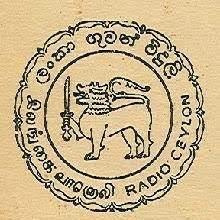
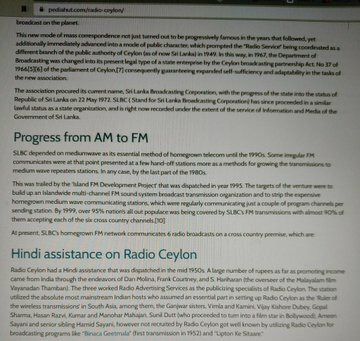


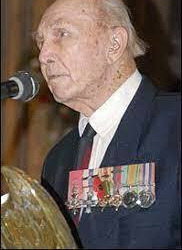

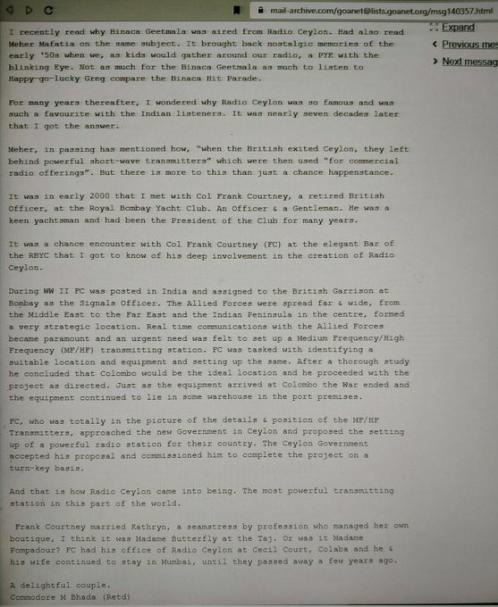

1 note
·
View note
Text
Balika Badhu is a 1976 Hindi romantic comedy-drama movie produced by Shakti Samanta and directed by Tarun Majumdar. The movie is founded on the Bengali novel by the exact name of Bimal Kar. This idealistic comedy-drama stars Sachin with Rajni Sharma, Asrani, A. K. Hangal, Asit Sen, Paintal, and Om Shivpuri. The music is by R. D. Burman and lyrics by Anand Bakshi, who authored several blows in the film including "Bade Achchhe Lagte Hain…", which was singer Amit Kumar's first hit, and featured on the Binaca Geetmala annual list in 1977 at 26. It was the second movie by Mrityunjay Sil.
0 notes
Text
October 11 - Living Legend BrAmHa B
BrAmHa B or Brother Amitabh Harivansh Rai Bachchan is the living legend of Hindi Cinema..
Some facts about the Man in a sort of a chronological sequence.. though not always with dates or years..
October 11 1942 - Birth - Born as the first son of Dr. Harivansh Rai Bachchan and Teji Bachchan at Allahabad (Now Prayagraj)
Attended Sherwood College Nainital - First introduction to Stage acting
Graduated in Science from Kirori Mal College, Delhi University
Served at Kolkata probably as a an executive at Blue Bird
Ajitabh pushes him to join Madhuri contest to join films (probably the same year as Rajesh Khanna is picked and he is not)
Comes to Bombay to try his luck in Hindi film Industry.. Khwaja Ahmad Abbas gives him his first chance to prove his worth with Saat Hindustani
November 1969 The first film wins him a national award
Many producers and directors turn him down stating ‘ Kaise baans jaise log bhi actor banane chale aate hain ‘
1971 Hrishikesh Mukherjee cast him as Babu Moshay or Dr.Bhaskar Banerjee in Anand along with Superstar Rajesh Khanna who was suffering from Cancer.. Wins his second national award.. I think as best supporting actor
Luck still does not favor him much films after films bear the label of flops including Bansi Birju with Jaya Bhaduri who had established herself as a great natural actor in Guddi with Hrishi Da..
The stories say he had almost decided to quit and return and had spent a night at Nariman Point benches (hearsay, I have no proof) when comedy star Mehmood took him home and made Bombay to Goa casting him in lead role opposite Aruna Irani
1973 Zanjeer released - He tastes the first success in a role which was turned down by quite a few heroes siting anti-hero image.. It seems pran sahab suggested Prakash Mehra to try it out with Amitabh Bachchan .. it unshackled his career like nothing before..
June 1973 Married Jaya Bhaduri at the request of his parents who permitted him to go with her for a vacation only if they could first marry..
Abhimaan and Namak Haraam established the Angry young man Image
Deewaar and Sholay with scripts from Salim-Javed launch him into superstardom at par with Rajesh Khanna or I would say even ahead of him that year.. as he also gave Chupke Chupke and Mili with Hrishi da in the same year
Yash Chopra experimented with him in Kabhi Kabhie to cast him into a romantic image.. the title song by Mukesh topped the charts at Binaca Geetmala
Manmohan Desai cast him in big budget film Amar Akbar Anthony along with Vinod Khanna and Rishi Kapoor in the title roles a film of lost and found sons it was a great blockbuster and set the trends for multistar films
1978 Don did so well in the times of mutistarrer films that he could pull up success with anything he touched .. The same year Trishul and Muqaddar Ka Sikandar also turned out to be mega blockbusters.. in spite of the fact that they were released within a short span of each other
His first decade ended on a high note with such success stories as mentioned above.. He was considered almost a sure shot for the success of a film
‘Mere Paas aao Mere Doston’ - Recorded first song as a playback singer for himself in Mr. Natwarlal
Yash Chopra cast him in a great film ‘Kaala Patthar’ without a single song for him and I consider it as one of the top films for him.. in fact he had not been offered many dialogues either .. his temperament alone made his role click so well
Real life rumors or stories of his affair with Rekha were weaved into a great film Silsila in 1981 by Yash Ji.. who must be said to be a director who really brought out the best in him besides Hrishi da
He is injured on the sets of ‘Coolie during a fight scene with Punit Issar and battles for life.. I think if I am right he was declared dead in some newspapers or bulletins only to be revived by doctors at Breach Candy Hospital.. His fans and family celebrate 2nd August as his second birth.. life after death.. too dramatic
During his battle for life producers and directors would often be going through anxious moments that had invested too heavily on him.. he was the most successful actor and superstar..
India and Indians prayed for his life in different places of worship.. here was a man who was above all cast and creed and would make his way into the hearts of millions of Indians of all ages
I conclude this first innings of his career slightly beyond the first decade of his life in Hindi film industry.. probably eight of my top 10 favorite films are from this first innings of his career.. he still acts and acts quite well at that.. Black 2005 and Piku much later are the only other two films which make into my top 10 fllms.. and not find a mention here
Love Affection and Respect
Abhaya Sharma
0 notes
Text
BINACA GEETMALA
Google defines MUSIC as a sound that has been organized by using rhythm, melody, or harmony. ... Music often has rhythm. Rhythm is the way the musical sounds and silences are put together in a sequence. Every tune has a rhythm that can be tapped.
Our lives would have been incomplete without MUSIC. Hearing good music soothes the brain, gives peace within, elevates the mood of the person, and brings positivity in us.
Music is said to be a healer. It is something we all are touched by. It is said that we have a deep connection with the music; it is hardwired in our brains and bodies. Music has been considered as very important right from ancient times. As per the American Music Therapy Association” The elements of music – rhythm, melody, etc. – are echoed in our physiology, functioning and being.” We all will agree to this fact, listening to our favourite song elevates the mood of a person, music acts as therapy.
Music acts as a stress buster. Listening to good music gives immediate relief from anxiety, headache, it stimulates our feelings and emotions, listening to some songs make us smile, some make us sad and some of them take us in the flashback of our lives and reminds us about the past events.
Today there are lots of countdown programs in various channels, but when it comes to the countdown of Hindi film songs, only one program comes to the mind and that is BINANCE GEETMALA and its announcer Ameen Sayani, his mesmerized voice… saying BAHANON AUR BHAIYON still echoes in our ears. He is still my favourite.
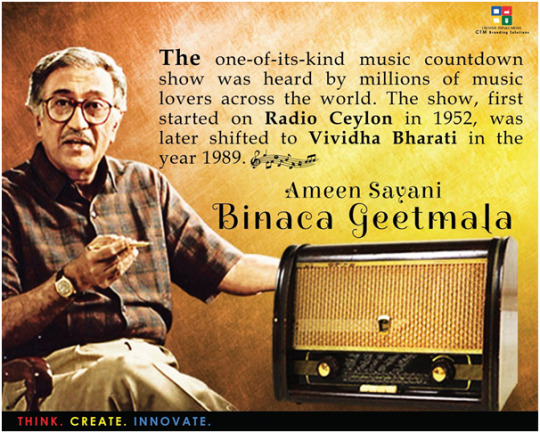
This famous music program would be remembered by all those reading the article, it used to be broadcast once in a week and I remember, I used to wait for the same. There used to be a lot of disturbance and the sound used to be vague, I used to stand near the radio and note down the countdown in my diary. It seems that the songs were numbered by Ameen Sayani based on the sale of the records. There used to be one number one song of the year. This famous program started in 1952 in Radio Ceylon and later in Vividh Bharti. It came to an end in 1994. It was Binaca Geetmala in the beginning and later the program name was changed to Cibaca Geetmala.
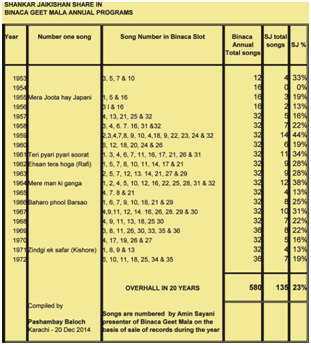
Though we hear many count down programs now still there has been no match for this program.
While expressing my feelings today through this article my favourite old hit songs of my favourite singers are echoed in my ears.
It is as if I have gone back to my old days and enjoying it.

During the lockdown, I saw Ameen Sayani’s interview in Doordarshan. He was remembering the old days and hearing the same itself was nostalgic for us. He is 87 and still going strong. His passion for music has still kept him young.
It is said MUSIC IS LOVE, MUSIC IS LIFE. Let’s enjoy music.

0 notes
Text
Hindi Sad Songs
Top Best Love Hindi Sad Songs List Latest (Broken Heart Songs)
2780
Everyone would love to hear music if you're happy or depressed but always like to hear the favorite tune, the best Hindi Sad Songs. There are a few men and women who like to listen to sad music. Mainly to comfort such individuals there are loads of depressing music available in the internet. If you're really in melancholy, then you can hear the sad tune about love which will give you a comfort in one sort.
In the Bollywood Hindi Mp3 Sad Song, you may download your favourite sad song in the listing of sad songs. On the top lies the gloomy tune download which permits you to get into deep feelings with no disturbance. Additionally, there are sad songs that make you cry when you listen to it. Sometimes you would prefer to hear depressing music that keeps you in sad mood and elevate your feelings.
I am sure, like each year, the weeks gone by have indicated the start of numerous fresh romances and seen a number of heartbreaks too. While the love struck ones were active conversing and canoodling with their respective partners, some were hoping to nurse their broken hearts . And if there is one common thing which accompanied all them, it is music. Some songs can spark the flame of passion amongst two lovebirds and some can soothe a wounded soul. Thankfully, Bollywood dished out a generous dose of beautiful numbers for each of those kinds in 2014. Here's a low-down on 20 love monitors that everyone MUST have in their playlists.
Talat Mahmood was one of Hindi films' most unique voices. He found success early as an All India Radio singer when he was just 16. A few popular ghazals afterwards, he proceeded to Calcutta to test his fortune in films. Talat Mahmood began his career as an actor-singer and proceeded to feature in films till 1958 but finally focused completely on singing. His understanding of Urdu and his excellent diction in the language made him a natural choice for ghazals in movies. But, his limited range and the decline of ghazals in movies in the 1960s and 1970s meant he could never become as popular as peers such as Mohammed Rafi and Kishore Kumar. His limited mass appeal aside, Talat's little body of work is of such high quality that he's considered amongst Hindi films' most important voices.
To mark the event of his 92nd birth anniversary on February 24, I list 10 of the most memorable tunes with 10 distinct music directors.
The gentle tremor in Talat Mahmood's singing voice didn't find broad acceptance among Hindi film music directors of this moment. It was Anil Biswas who saw the charm within this tremor and asked Talat to embrace it. The end result was Talat's first strike,'Ae Dil Mujhe Aisi Jaga Le Chal'. My pick is'Shukriya Shukriya' since it features on screen a dashing Talat, who had an acting role in the film.
'Mohabbat Mein Aise Zamane Bhi Aaye' (Sagai, 1951) -- C Ramchandra
Talat Mahmood's best for C Ramchandra was likely for the film Parchhain (1952). Talat sang four lovely songs in the film including the brilliant solo'Mohabbat Hi Na Jo Samjhe' which I listed in C Ramchandra's best 10 songs. 'Mohabbat Mein...' is a miserable song with a remarkably upbeat and lively arrangement consisting of a piano, saxophone and a sitar. It may not be their most popular song together but it's one of the ones that feature Lata and Talat at the peak of the singing skills.
Anil Biswas continued to bat for Talat Mahmood in movies he wasn't connected with. When Shankar--Jaikishan chose to use Mukesh as Dilip Kumar's voice in Daag, it had been Anil da who directed them towards Talat Mahmood. The movie's winner was easily'Ae Mere Dil Kahin Aur Chal' in three different versions-- two Talat solos along with a Lata solo. In the quick variant, Talat's quiver sounds a little strained but at the slow variation he is totally at ease and at his intoxicating best.
Talat's finest for Roshan is readily among his finest ever--'Main Dil Hoon Ek Armaan Bhara'. Roshan ordered this mellow, free-flowing ghazal beautifully as a piano tune and Talat's singing is the embodiment of a heart filled with desire.
OP Nayyar employed Talat Mahmood for just three songs in his entire career. Two out those probably went to Talat simply since he played a lead part in it 'Sone Ki Chidiya' (1958). Considering how great these three songs were, we can only wonder what could have been when OP Nayyar had been open about his selection of singers. My selection of these three songs is the one Talat sang for an actor besides himself--'Mujhe Dekho Hasrat Hi Tasveer Hoon Main' for Guru Dutt.
Apart from being amongst the first couple of films of Shammi Kapoor before he turned into a celebrity, the only notable thing about Thokar was that the magnificent Talat solo,'Ae Ghame Dil Kya Karoon', written by Sardar Malik and composed by Majaz. The film also had a thoroughly competent version of the song by Asha Bhosle, but Talat's version completely overshadowed it.
Footpath was a fine film with some superb acting by Dilip Kumar but remains sadly underrated. Khayyam had to make his mamark, bute gave the audiences a glimpse of his immense talent in'Shaam-E-Gham Ki Kasam'. Seeing Dilip's understated performance in this song, it becomes clear why Talat's gentle but true voice was a perfect match for the legendary actor.
SD Burman experimented with Talat as Dev Anand's voice in Arman(1953) and in Taxi Driver (1954) before switching entirely into his two favourites, Kishore Kumar and Mohammed Rafi. SD Burman's move away from Talat occurred despite the achievement of Taxi Driver. The film's score won SD Burman the Filmfare Award for Best Music Manager and in the very first year the radio show Binaca Geetmala had the yearly countdown of bethe bestongs, Talat's version of'Jaayen To Jaayen Kahan' hit the number 1 place.
You Also Read
0 notes
Text
Yesudas is a legendary singer, and his songs are loved by millions. We're excited to share the "Yesudas song lyrics". This is all about staying positive and keeping your spirits up, no matter what life throws at you. It's a perfect pick-me-up for when you're feeling down. All the lyrics to your favorite songs, now in one place. Check it out now and sing along to your heart's content. Visit for more: https://www.keepalivebollywood.com/
#old hindi songs#binaca geetmala#binaca geetmala hindi songs#binaca geetmala 1960 to 1970#music#filmfare award winners 1960#aesthetic#yesudas song lyrics#filmfareawards#old hindi songs lyrics
0 notes
Text
Binaca Geetmala 1952
Binaca Geetmala 1952 was a part of Geetmala (popularly known as Binaca Geetmala), a Radio Show that ranked Bollywood Hindi Songs. The show started on 3 December 1952, and was initially broadcasted during 8 PM to 8:30 PM.
Binaca Geetmala started broadcasting in 1952 on Radio Ceylon and lasted in the year 1988. After 1988, the program shifted to Vividh Bharati of All India Radio. The show…
View On WordPress
0 notes
Video
youtube
Actress Suchitra Sen was the first Indian actress to be bestowed with an award in an international film festival.

The actress was the recipient of the Best Actress trophy at the Moscow Film Festival for her remarkable work in Saat Pake Bandha, a film that released in 1963.
Saat Pake Bandha (Bengali: সাত পাকে বাঁধা) (1963) is a Bengali romantic film starring Soumitra Chatterjee, Suchitra Sen, Pahari Sanyal and Tarun Kumar. Directed by Ajoy Kar, it was a box office success upon its release.
Professor Sukhendu Dutta (Soumitra Chatterjee), a well-educated poor orphan, who lives with his aunt in a small apartment in Kolkata. Along with the regular job in the university, he also earns his living by private tuition. He met Archana Basu (Suchitra Sen), a well-educated woman of rich family background in a private party thrown in honour of a student of Sukhendu. After that, they fell in love and got married. Archana's mother was not happy with the marriage from the beginning, considering the poor income of Sukhendu. Eventually her too much interference in the married life of Sukhendu and Archana led to a mutual separation.
Cast
Soumitra Chatterjee as Sukhendu Dutta
Suchitra Sen as Archana Basu
Pahari Sanyal as Archana's Father
Chhaya Devi as Archana's Mother

The movie was remade in 1963 in Telugu as Vivaha Bandham, in 1974 in Hindi as Kora Kagaz and in Tamil as Lalitha in 1976.
youtube
Kora Kagaz is a 1974 Hindi drama film produced by Sanath Kothari and directed by Anil Ganguly. The film stars Vijay Anand, Jaya Bhaduri, A.K. Hangal, Achala Sachdev and Deven Verma. The films music is by Kalyanji Anandji. The famous title song "Mera Jeevan Kora Kagaz" was by Kishore Kumar.
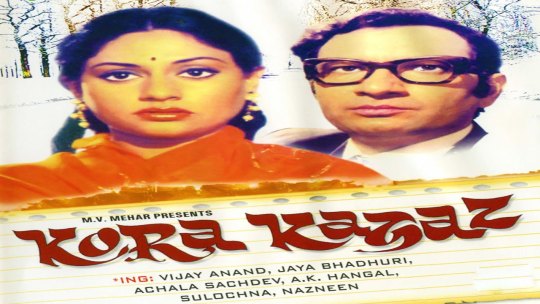
At the 22nd National Film Awards, it won the award for Best Popular Film Providing Wholesome Entertainment, while Lata Mangeshkar won the award for Best Female Playback Singer.The film is a remake of 1963 Bengali film Saat Pake Bandha directed by Ajoy Kar, and starring Suchitra Sen which itself was based on the story Saat Paake Bandha by Ashutosh Mukhopadhyay,
Professor Sukesh Dutt (Vijay Anand) and Archana Gupta (Jaya Bhaduri) meet each other in a chance encounter while traveling by BEST bus service in Mumbai. Their meeting again results in formal introduction to each other. Both get attracted to each other and get married. Archana's mother does not like Sukesh due to his modest income. She makes up stories about their affluence, which offends Sukesh. This results in acrimony between Archana and Sukesh, and they decide to separate. Archana goes to live with her parents, while Sukesh relocates. Archana's family asks her to forget Sukesh, and remarry, which Archana finds difficult since she still has feelings for Sukesh.
Cast
Vijay Anand as Professor Sukesh Dutt
Jaya Bhaduri as Archana Gupta
A. K. Hangal as Principal Gupta
Achala Sachdev as Mrs. Gupta
Nazneen as Aruna Gupta
Dinesh Hingoo as Govind Gupta
Ramesh Deo as Archana's Uncle
Seema Deo as Archana's Aunt
Sulochana Latkar as Sukesh's Aunt
Master Shahid as Deepak
Deven Verma as Drona Acharya
Crew
Director - Anil Ganguly
Story - Ashutosh Mukherjee
Screenplay - Surendra Shailaj
Dialogue - M. G. Hashmat
Producer - Sanat Kothari
Cinematographer - Bipin Gajjar
Art Director - Abdul Rahim
Choreographer - Suresh Bhatt, Praveen Kumar
Music Director - Kalyanji Anandji
Lyricist - M. G. Hashmat
Playback Singers - Kishore Kumar, Lata Mangeshkar
Editor - Waman B. Bhosle, Guru Dutt
Music
Song "Mera Jeevan Kora Kagaz" topped the Binaca Geetmala annual list 1974
Song Title Singers
"Mera Jeevan Kora Kagaz" Kishore Kumar 3:35
"Mera Padhne Mein Nahin Lage Dil" Lata Mangeshkar
"Roothe Roothe Piya" Lata Mangeshkar
Awards and nominations
National Film Award
Best Popular Film Providing Wholesome Entertainment : Anil Ganguly
Best Female Playback Singer: Lata Mangeshkar for the song "Roothe Roothe Piya.
Filmfare Awards
Won
Filmfare Best Actress Award - Jaya Bachchan
Filmfare Best Music Director Award - Kalyanji Anandji
Nomination
Best Film
Best Director - Anil Ganguly
Best Story - Ashutosh Mukhopadhyay
Best Lyricist - M.G.Hashmat for the song "Mera Jeevan Kora Kagaz"
Best Male Playback Singer - Kishore Kumar for the song "Mera Jeevan Kora Kagaz"
BFJA Awards
Lata Mangeshkar - Best Female Playback Singer in Hindi film section
Kishore Kumar - Best Male Playback Singer in Hindi film section
Kalyanji Anandji - Best Music Directors in Hindi film section
M.G.Hashmat - Best Lyricist in Hindi film section.
0 notes
Photo


Tributes to Pandit Narendra Sharma, the legendary poet, Hindi film lyricist and the founder of Vividh Bharati on his death anniversary today.
Pandit Narendra Sharma was a poet and lyricist, writer and intellectual as well as a journalist who has penned unforgettable poems, literature and lyrics in films. A Hindi Urdu scholar, he combined the tradition of Kabir and Meera with the lyricism of ghazals and Urdu poetry to provide Indian cinema with the Hindi language that was rich in the literature of Allahabad and Ganga. He was the man who evolved the face of All India Radio during its drowning stage by establishing popular Radio channel Vividh Bharati and generated listeners that went upto an amount of almost 35 crores.
He wrote some memorable songs for hindi films like "Jyoti Kalash Chhalke" (Bhabhi Ki Chudiyan - 1961) ,“Yashomati maiya se bole nandlala” (Satyam Shivam Sundaram – 1979) and the title song “Satyam Shivam Sundaram” (Satyam Shivam Sundaram – 1979).
Pandit Narendra Sharma was born on 28th of February 1913 in the Jahangirpur district of Uttar Pradesh. He completed his MA in English literature from Allahabad University before participating in the struggle for Indian independence. His travails during those times helped shape his morality and thirst for literature. Belonging to the same batch as another illustrious peer, Harivanshrai Bachchan, Sharma immersed himself in Hindi poetry. His works were viewed with great respect and love among his peers as well as his readers. It was in 1942 that Bhagwati Charan Varma, author of 'Chitralekha', brought him to the city of Bombay to work as a lyricist with the famed Bombay Talkies.
During this time, Devika Rani's best team had disbanded. Kavi Pradeep, the foremost lyricist of Bombay Talkies had already had his differences and left the studio. Bhagwati Charan Varma, who wrote 'Pratima' for Bombay Talkies, suggested Narendra Sharma's name to Devika Rani. Pandit Narendra Sharma's first film as a lyricist was for Raj Kapoor and Devika Rani starrer 'Hamaari Baat' (1943). Under the maestro, Anil Biswas, he found a composer who understood the tone and the temperament of his classical lyrics. Sharma's next film was the debut of a young, handsome man named Yusuf Khan. The only problem was that the young man did not wish to be featured under his own name. So, the writers of Bombay Talkies were tasked with the job of coming up with a name for their hero. It was Pandit Narendra Sharma who suggested the name 'Dilip Kumar'. It would go on to become one of Indian cinema's most recognized and influential names for the next century. The classical lyrics of his songs found the ideal singer in Lata Mangeshkar. Her rendition of 'Jyoti kalash challke' and 'Satyam shivam sundaram' remain the most memorable. Another very popular number is 'Naach mayura' in the melodious voice of Manna Dey.
Films were not the only benchmark by which Pandit Narendra Sharma's contribution to Indian cinema can be measured. In 1952, he was invited by Prime minister Jawaharlal Nehru to manage the new branch of All India Radio. They named it 'Vividh Bharati'. Under Pandit Narendra Sharma, Vividh Bharati grew to become one of the main public media in India. Its listenership grew to a record 97% by the year 1970. Some of the most important radio programmes like Binaca Geetmala took the country by a storm. This programme was vital to regenerating interest in Hindi film songs and its lyrics. He remained with ‘Vividh Bharati’ until his retirement. After attending the age of retirement he went back to his lyrical world.
Pandit Narendra Sharma also did write many non-filmy bhajans and devotional songs. ‘Satrang Chunar Navrang Paag’, ‘Naach Re Mayura Bolkar Sahasra Nayan’ ‘Aiye Prabhui Aaiye’ are some of his famous non-film poems.
One of his most famous works is the title track of Raj Kapoor's Satyam Shivam Sundaram. The philosophical lyrics of the song weave an intricate thread about beauty and truth and their divinity. The popularity of this song and its complexity earned the lyricist his first Filmfare nomination.
On 11th February 1989, the great lyricist breathed his last. A poet who spoke about the presence of divinity in everything, Pandit Narendra Sharma's lyrics evoke the greatest truth of art - Art is truth and truth is the beauty.
3 notes
·
View notes
Text
Binaca Geetmala was a popular radio program in India that featured Hindi film songs. It was broadcast on the All India Radio network. The program became very popular, Many famous Bollywood singers and actors participated in the program, including Lata Mangeshkar, Mohammed Rafi, Kishore Kumar, Amitabh Bachchan, and Dilip Kumar. The program also gave listeners a chance to request their favorite songs. Binaca Geetmala was a cherished part of many people's childhoods and continues to be fondly remembered by those who grew up listening to it. Keep Alive is the ultimate app for Hindi songs. To enjoy Binaca Geetmala Hindi Songs download now and listen to thousands of Bollywood songs, old and new. Visit for more: https://www.keepalivebollywood.com/
#binaca geetmala#filmfareawards#binaca geetmala 1960 to 1970#yesudas song lyrics#music#old hindi songs#binaca geetmala hindi songs#old hindi songs lyrics#filmfare award winners 1960
0 notes
Text
Awaken Your Senses with the Most Beautiful Ghazals by Jagjit Singh – An Unforgettable Voyage

Bollywood, the vibrant and diverse film Industry of India, has been a melting pot of various musical genres, enriching the cultural landscape of the country. Amidst the glitz and glamour, one artist’s soulful melodies have left an enduring impact on the hearts of millions – Jagjit Singh, the Ghazal maestro. Jagjit Singh’s ghazals have carved a unique niche in Bollywood music, evoking emotions that transcend time and boundaries. Join us as we dive into the enchanting realm of ghazals, guided by the mesmerizing melodies of the legendary Jagjit Singh. Prepare to be captivated by his velvety voice, poignant lyrics, and heartfelt compositions in this unforgettable voyage through the most beautiful ghazals ever created. Soothing yet powerful, these timeless gems have the power to touch your heart and ignite emotions you never knew existed. Get ready for an experience like no other – let’s delve into the magic together!
Introduction to Jagjit Singh and His Music
Ghazals are a form of Urdu poetry which originated in Persia. The word ‘ghazal’ is derived from the Arabic word for ‘talk’ or ‘conversation’. Ghazals are typically about love, loss and longing, and Jagjit Singh was one of the most popular ghazal singers of all time.
Jagjit Singh was born in 1941 in Sri Ganganagar, Rajasthan, India. He started learning music at a young age and went on to study classical music at Mumbai’s Khalsa College. In the early 1960s, he began his career as a playback singer for Bollywood films. He went on to release several successful albums of ghazals, including The Unforgettable Ghazals of Jagjit Singh (1980), A Sound Affair (1985) and Mirza Ghalib: In Revival (1988).
Jagjit Singh’s rich baritone voice and soulful renditions of ghazals won him millions of fans around the world. His ghazals often had a spiritual quality to them, and he was known for his ability to touch people’s hearts with his music. He passed away in 2011, but his music continues to live on and inspire people all over the world.
A Detailed Look at the Most Popular Ghazals from His Collection
Jagjit Singh’s ghazals are some of the most beautiful and popular pieces of music in India. Let’s take a look at some of the most popular ghazals from his collection.
1. “Hothon Se Chhu Lo Tum”
This song is a timeless ghazal from the 1981 film “Prem Geet.” Sung by the maestro Jagjit Singh, with lyrics by Gulzar and music composed by Jagjit Singh himself, the song is a heartfelt expression of love and desire. The ghazal beautifully weaves together poetic verses and evocative melodies, showcasing Jagjit Singh’s mastery in evoking emotions through his soulful voice. “Hothon Se Chhu Lo Tum” has remained an eternal favorite among music enthusiasts, leaving a lasting impression with its tender and passionate portrayal of love’s yearning and the depth of emotions it stirs.
2. “Hoshwalon Ko Khabar Kya”
Hoshwalon Ko Khabar Kya” is a soul-stirring ghazal from the 1999 film “Sarfarosh.The song explores the complexity of human emotions, particularly the ineffable feeling of being in love. The ghazal’s lyrics are rich in metaphors and deep philosophical reflections, while Jagjit Singh’s mesmerizing voice infuses the song with an ethereal quality.
3. “Chitthi Na Koi Sandesh”
This Ghazal is a heart-rending song from the 1997 film “Dushman about the pain of separation. The lyrics talk about how letters from loved ones only serve to remind us of their absence, and how this pain can never be erased. Jagjit Singh’s emotive rendition and soulful voice strike a chord with listeners, bringing out the raw emotions of loss and grief.
4. “Tum Itna Jo Muskura Rahe Ho”
The song beautifully captures the bittersweet emotions of love and longing, and Jagjit Singh’s velvety voice adds a touch of melancholy to the heartfelt lyrics. The song’s simple yet profound melody and heartfelt rendition have made it an evergreen classic, touching the hearts of listeners for decades and earning a special place in the repertoire of Indian music.
How Jagjit Singh’s Voice and Lyrics Captivate Listener’s Heart
There are ghazals, and then there are Jagjit Singh ghazals. The renowned singer has a unique voice that is both melancholic and soothing, which perfectly complements the heart-wrenching lyrics of his ghazals. Whether he is singing about unrequited love, lost opportunities, or the pain of separation, Jagjit Singh always manages to touch listeners’ hearts with his soulful voice and moving lyrics.
One of the things that makes Jagjit Singh’s ghazals so special is that he often chooses to sing traditional Urdu poetry instead of contemporary lyrics. This gives his music a timeless quality that resonates with people of all ages. Furthermore, Singh’s beautiful renditions of classic ghazals by poets such as Mirza Ghalib and Faiz Ahmad Faiz are truly mesmerizing.
So if you’re looking for some soulful music to help you relax and reflect on life, be sure to give Jagjit Singh’s ghazals a listen. You’re sure to fall in love with his voice and words!
An Overview of the Ghazal Genre and Its Origins
The Ghazal is a genre of poetry that originated in Persia and is now popular in South Asia. The Ghazal typically consists of couplets (two lines of verse) that share a rhyme and have a similar meter. The first line of each couplet is known as the radif, while the second line is called the kafiya.
The Ghazal often features themes of love, loss, and longing. It is said to be one of the most romantic and lyrical genres of poetry. Many famous poets have written Ghazals, including Rumi, Hafiz, and Mirza Ghalib.
Jagjit Singh was one of the most famous Ghazal singers of all time. He popularized the genre in the 20th century with his soulful voice and beautiful renditions of classic Ghazals. HisGhazals are known for their passion, intensity, and emotionality.
If you’re looking to experience the beauty of the Ghazal genre, there’s no better place to start than with Jagjit Singh’s music. Sit back, relax, and let his voice take you on an unforgettable journey.
Themes and Motifs Found in Jagjit Singh’s Ghazals
Jagjit Singh’s Ghazals are some of the most beautiful and evocative pieces of music ever composed. They are known for their intricate melodies, soulful lyrics, and passionate delivery. Here are some of the themes and motifs found in Jagjit Singh’s Ghazals:
Love: One of the most common themes in Jagjit Singh’s Ghazals is love. Whether it is unrequited love, lost love, or forbidden love, Jagjit Singh’s Ghazals always manage to capture the essence of what it feels like to be in love.
yearning: Another common theme in Jagjit Singh’s Ghazals is yearning. This is often expressed through longing for a lost love, or for something that can never be attained. There is a sense of bittersweet nostalgia in theseGhazals, as they remind us of what we have lost, or what we can never have.
Saudade: Saudade is a Portuguese word that describes a deep feeling of longing or nostalgia. This is another common theme in Jagjit Singh’s Ghazals, which often deal with loss and separation. Saudade is a particularly apt word to describe the emotions evoked by Jagjit Singh’s music, as it conveys both the sadness and beauty of remembering something that is no longer there.
Hope: In spite of all the sorrow and longing expressed in Jagjit Singh’s Ghazals, there is also an underlying sense of hope. This is often expressed through the idea of love conquering all, or of living each day with joy and optimism. These themes of hope are a testament to Jagjit Singh’s ability to capture both the sorrow and beauty of life in his music.
How Jagjit Singh’s Influence Has Changed the Ghazal Scene
Jagjit Singh’s influence on the ghazal scene has been transformative and far-reaching. He revolutionized the traditional genre of ghazals, bringing it into the mainstream and making it accessible to a wider audience. Here are some key ways in which Jagjit Singh’s influence has changed the ghazal scene:
Modernization of Ghazals:
Before Jagjit Singh’s entry into the music industry, ghazals were primarily confined to classical settings and were considered a niche genre. Singh introduced a contemporary touch to ghazals, blending classical elements with modern instruments and arrangements. This approach made the ghazal genre more relatable to a younger audience, leading to its widespread popularity.
Introduction of Female Voices:
Traditionally, ghazals were predominantly sung by male artists. Jagjit Singh collaborated with his wife, Chitra Singh, and together they released several duet albums. Chitra Singh’s melodious voice added a new dimension to ghazals, making them more inclusive and appealing to female listeners.
Reaching a Broader Audience:
Jagjit Singh’s soulful voice and emotive singing style resonated with people from all walks of life. His ability to express complex emotions through his ghazals made them relatable to a diverse audience. As a result, ghazals moved beyond the limited sphere of connoisseurs and found a place in the hearts of millions, both in India and abroad.
Collaborations with Lyricists:
.Jagjit Singh collaborated with some of the finest lyricists in the industry, such as Gulzar, Javed Akhtar, and Kaifi Azmi. This collaboration resulted in meaningful and evocative lyrics that resonated with listeners on a profound level. The combination of Singh’s soulful voice and poignant lyrics elevated the ghazal genre to new heights.
Influence on Future Artists:
Jagjit Singh’s unique style and approach to ghazals inspired a new generation of musicians and singers. Many artists were influenced by his emotive singing and sought to emulate his ability to evoke deep emotions through their music.
Ghazals in Bollywood:
Jagjit Singh’s success in Bollywood brought ghazals to the forefront of the film industry. His soulful ballads in movies like “Arth,” “Sarfarosh,” and “Prem Geet” became huge hits, and filmmakers began to include ghazals in their soundtracks more often. This further popularized the genre among the masses.
Rediscovery of Traditional Ghazals:
While Jagjit Singh introduced a contemporary touch to ghazals, he also paid homage to the classical roots of the genre. His renditions of traditional ghazals brought them back into the spotlight, ensuring that the rich heritage of ghazals was not forgotten.
Conclusion:
Jagjit Singh’s influence on the ghazal scene has been nothing short of revolutionary. He breathed new life into the genre, making it more accessible, emotionally resonant, and appealing to a broader audience. His legacy continues to inspire and shape the world of ghazals, ensuring that this beautiful form of music will live on for generations to come
#Awaken Your Senses with the Most Beautiful Ghazals by Jagjit Singh – An Unforgettable Voyage#old hindi songs#yesudas song lyrics#binaca geetmala hindi songs#filmfareawards#binaca geetmala 1960 to 1970#music
0 notes
Text
Bollywood’s Musical Kaleidoscope: The Art of Incorporating Whistling, Yodelling, and Bell Sounds
Welcome to the enchanting world of Bollywood, where silver screens come alive with vibrant colors and pulsating music. A kaleidoscope of melodies that transports us into dreamy realms, leaving our hearts dancing in rhythm. But have you ever wondered what makes these musical creations truly extraordinary? Join us as we unravel the secrets behind Bollywood’s unique blend of whistling, yodeling, and bell sounds – an art form that elevates cinema to a whole new level of auditory ecstasy. Get ready to be mesmerized by the magical symphony that sets Bollywood apart from any other industry on Earth! Visit More - www.keepalivebollywood.com/
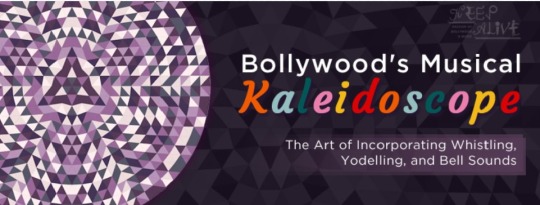
#Bollywood’s Musical Kaleidoscope: The Art of Incorporating Whistling#Yodelling#and Bell Sounds#binaca geetmala#yesudas song lyrics#binaca geetmala hindi songs#old hindi songs lyrics#filmfare award winners 1960#aesthetic#filmfareawards#old hindi songs#music#binaca geetmala 1960 to 1970
0 notes
Text
Best Of Asha Bhosle Duets
Asha Bhosle is one of the most iconic singers in Indian music. She has sung over 10,000 songs from different languages and is often referred to as "The Nightingale of India." Asha bhosle duets have a charm and appeal that is unmatched. They transport us to another era, when love was simple and life was carefree. There is something about these songs that just makes us feel good. They are the perfect way to unwind after a long day or to get the party started. And what's even better is that they are now available to stream online, so you can enjoy them anytime, anywhere. Keep alive is always bringing some amazing music for their listeners. Visit for more: https://www.keepalivebollywood.com/
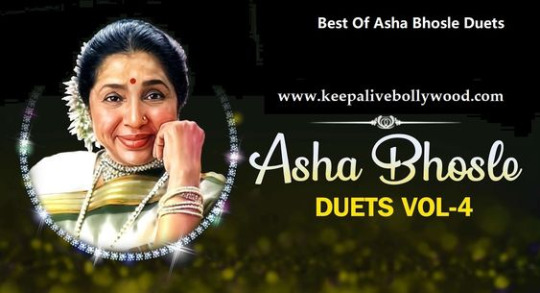
#Best Of Asha Bhosle Duets#ed but not sheeran#old hindi songs#yesudas song lyrics#binaca geetmala hindi songs#filmfareawards#old hindi songs lyrics#filmfare award winners 1960#binaca geetmala 1960 to 1970#binaca geetmala
0 notes